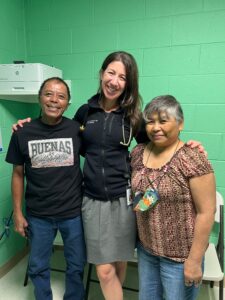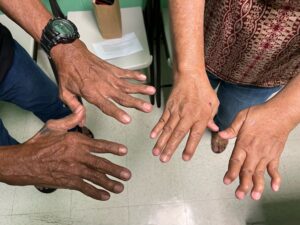“What are you up to this weekend?”
“Flying to Guam.”
“What? Why?”
“I promised an entire island I’d be their doctor.”
In fall 2021, Jonathon Thorp, MD, phoned a friend. A passionate internist, he was bound and determined to bring a rheumatologist to Guam. Unlike most primary care providers (PCPs), he was willing to prescribe disease-modifying anti-rheumatic drugs (DMARDs) and biologics. But he needed help.
The friend he phoned was a friend of mine. My friend said, “I’ve got two kids and a full-time private practice job. I can’t swing it. But Sam just resigned from her academic gig and loves to travel. Call her.”
The conversation that followed went something like this:
Dr. Thorp: “Hi, I’m a PCP on Guam. Our island has no rheumatologist. Those who can afford it have to fly four hours to the Philippines for care. We can’t pay you much, but we can fly you out here and give you a place to stay. Would you consider coming down to help?”
Me: “Sure. Let me just Google where Guam is.” (Answer? Far away).
Eight months and 200 handwritten forms mailed to the Guam Board of Medical Examiners later, I arrived. My clinic was booked solid for my entire four-week stay. The waiting list in case of cancellation was an additional 80 patients long.
Background
If Guam sounds foreign to you, join the club. Guam is the westernmost territory of the U.S., located in the Micronesia subregion of the western Pacific. Spain ceded Guam to the U.S. following the Spanish-American War in the late 19th century. People born on Guam are U.S. citizens. They’re eligible for certain federal programs, such as Medicare and Medicaid, but cannot vote for president.
Island Doc Living
It’s 5 a.m. The alarm goes off, and I work out at a gym called Paradise Fitness. As I head home, the sun peaks through the clouds over the sea, and I spot a rainbow. This is not a drill.
I prepare for my morning “commute,” donning flip-flops. I tread 50 yards across a grassy hill to the clinic. I wipe the mud off my feet, put on my flats and see my first patient.
Example 1: Mr. A is a 52-year-old U.S. Navy veteran who presents for chronic joint pain. Like many Chamorro men, he has gout. Daily allopurinol at a dosage of 300 mg controlled his disease for years, but he lost access to the medication months ago. His disease flared. His PCP restarted allopurinol, without flare prophylaxis. His flares worsened. Given persistent inflammatory arthritis, an anti-nuclear antibody (ANA) was checked, which was positive at a titer of 1 to 80.
“It might be lupus,” his PCP said. “A rheumatologist is visiting the island in a few months. I’ll place a referral.”
By the time Mr. A saw me, he was a shell of himself. His hands and feet were painful and swollen, forcing him to leave his job at the naval base. Worry about a potential lupus diagnosis led to crippling anxiety. He could no longer get through the day without alprazolam.
I pulled out a piece of paper and drew a bathtub. I explained the basics of urate-lowering therapy, the need for flare prophylaxis and target serum urate levels. “Gout is curable—it’s just a matter of getting you on the right medicines at the right doses, and staying on them,” I said.1
Then, I reassured him that his positive ANA test wasn’t clinically significant. I’ve never seen a grown man so happy. “You mean I don’t have ‘Anna’? Thank you, Dr. Sam!” he exclaimed.
Example 2: Later that afternoon, I met Mr. and Mrs. G. They’d been married for 31 years and both had erosive seropositive rheumatoid arthritis (see Figure 1). I was the first rheumatologist they’d ever met—a fact to which their hands could attest (see Figure 2). They were taking methotrexate, but it simply wasn’t enough. They needed biologics—decades ago.
What struck me most about these two wasn’t their matching ulnar deviations, but their positivity. “It’s not so bad, Doc. We barely notice the pain anymore; it’s just part of life. And we have each other,” Mrs. G said.
On the other hand, I felt incensed. There were medications out there that could help. They simply couldn’t access them.
Access
If the people of Guam are U.S. citizens, why is access such a problem?
For one thing, Guam is really far away. It’s a federally designated Health Professional Shortage Area (HPSA) because there just aren’t many specialists on the island.2 When I said that I was flying to Guam that weekend, I literally meant the entire weekend. I departed Austin, Texas, at 8 a.m. on Saturday morning. I arrived in Guam at 10 p.m. on Sunday night.
Lack of insurance is another barrier. An estimated 23% of people on Guam are uninsured or underinsured, and they don’t qualify for most drug company-sponsored patient assistance programs that provide free biologics to stateside residents.2,3 Even for patients with private health insurance, high co-pays often render biologics cost prohibitive.
E-Consults
Every patient visit ended the same. Sincere gratitude, followed by this dreaded refrain: “When are you coming back? Who will help me after you leave?”
I’ve left the island. But I established a rheumatology electronic consultation (e-consult) service prior to departure. E-consults are essentially HIPAA-compliant curbside consults.4 Although imperfect, a lot of care can be provided via simple chart review and PCP-to-specialist correspondence. With guidance readily available, PCPs at the clinic feel more comfortable managing rheumatic conditions. As comfort levels grow, patients reap the benefits.
Want to help?
Providing rheumatologic care on Guam was one of the most rewarding experiences of my life. I helped patients in need. I watched the sun set over the ocean every night (see Figure 3). I learned how to scuba dive. I made a difference. You can help too. Embrace your inner island doctor, and go for it. Tell them I sent you (see sidebar below).
 Samantha C. Shapiro, MD, is the executive editor of Harrison’s Principles of Internal Medicine. As a clinician educator, she practices telerheumatology and writes for both medical and lay audiences.
Samantha C. Shapiro, MD, is the executive editor of Harrison’s Principles of Internal Medicine. As a clinician educator, she practices telerheumatology and writes for both medical and lay audiences.
References
- Shapiro SC. How long should I take my gout medicine? GoodRx Health. 2022 Mar 8.
- III.B. Overview of the state—Guam—2021. HRSA Maternal and Child Health. https://mchb.tvisdata.hrsa.gov/Narratives/Overview/08312f4f-d1b8-4988-a861-b6aa9678a13e.
- Shapiro SC. The ins & outs of patient assistance programs. The Rheumatologist. 2022 Mar 23.
- Shapiro SC. Electronic consultations could improve access to rheumatologic care. The Rheumatologist. 2022 Jan 20.
The Guam Seventh-day Adventist Clinic is a nonprofit clinic that has served the island people for the past 65 years. For more information, visit http://www.adventistclinic.com. If you’re interested, email a copy of your curriculum vitae to [email protected].





